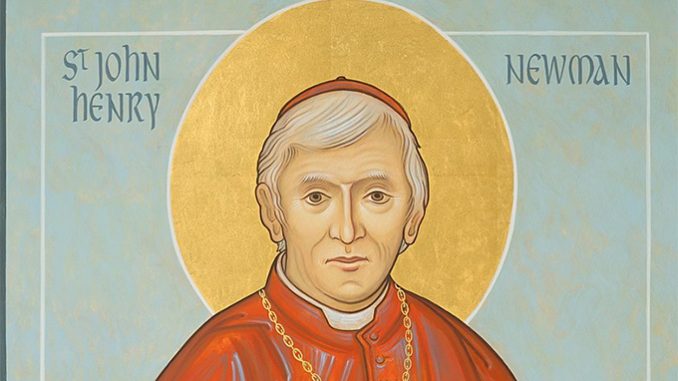
The All Saints Day proclamation of St. John Henry Newman as a Doctor of the Church was entirely welcome, if not without a certain irony.
First, the good news.
Newman was one of the most creative Christian minds of the nineteenth century, a truth seeker whose lifelong search for the face of Christ took him from evangelicalism through reformist, High Church Anglicanism into Catholicism. Along that sometimes-stony path, Newman was misunderstood and slandered, frustrated by ecclesiastical bureaucracy and beset by clerical jealousies.
Yet the vicissitudes of his life led him to write several of the most consequential books of his time, volumes that retain their salience a century and a half later: Apologia Pro Vita Sua (with Augustine’s Confessions, one of the great Christian autobiographies); The Idea of a University (required reading for those working in institutions of higher learning claiming to be Catholic); and An Essay in Aid of a Grammar of Assent (a masterpiece in both the philosophy and psychology of faith). His Parochial and Plain Sermons are homiletic and stylistic gems, and his Prayers, Verses, and Devotions make for rich spiritual reading.
And then there is An Essay on the Development of Christian Doctrine. This brilliant explication of how doctrine develops organically from within, while never displacing or distorting the truths of biblical revelation or Christian tradition, not only led Newman into full communion with the Catholic Church. In the century after its 1845 publication, the Essay helped create the theological conditions for the possibility of the Second Vatican Council’s teaching on the Church, on divine revelation, on religious freedom, on ecumenism, and on issues of Church-and-state.
Moreover, Newman’s criteria for distinguishing true developments of doctrine from fallacious ruptures with the tradition remain a powerful refutation of those who claim that, at Vatican II, the Church underwent a “paradigm shift.” Confronting that notion, I am confident that our newest Doctor of the Church would respond (with more elegance than I can muster) that such claims display an ignorance of what a “paradigm shift” is, an ignorance of how doctrine develops, or both.
Yet for all that he is, today, a touchstone of Catholic orthodoxy, in his time Newman was held in the deepest suspicion by 19th-century ultramontanists, whose absurdly expansive view of papal infallibility tended to turn the pope into an oracle who spoke divinely warranted truth on virtually any subject. Newman’s far more precise understanding of both the fact and the limits of papal infallibility won the day at the First Vatican Council but further aggravated his relationship with his fellow English convert, Cardinal Henry Edward Manning, a leader of the ultramontanist party. Yet it was Newman, not Manning, who, in his Letter to the Duke of Norfolk, offered the most persuasive defense in Great Britain of what Vatican I had taught about the pope and the papacy.
Pope Leo XIII put paid to the ultramontanists’ anti-Newman campaign by naming Newman a cardinal in one of the first historic acts of one of the most important pontificates in centuries. So it was vere dignum et iustum that the new Leo, the fourteenth of that papal name, should have declared Newman a Doctor of the Church (although I can report that John Paul II said over dinner in December 1997 that he hoped Newman would be Doctor Ecclesiae one day, a view certainly shared by Benedict XVI).
The irony of Newman being given this rare honor just now lies in the fact that the unity of the Church is threatened by recrudescent ultramontanism: not the old, 19th-century reactionary model, but a new hybrid combining Catholic progressivism in the realm of ideas with liberal authoritarianism in Church governance.
It’s the kind of ultramontanism that leads commentators to describe respectful disagreements with aspects of Pope Francis’s teachings as “not just dissent from, but animus towards, the papal magisterium of the late pope.” That ridiculous charge—a calumny, really—was not uncommon over the past twelve years; was it a factor this past August when three distinguished faculty members were summarily cashiered from their positions at Detroit’s Sacred Heart Major Seminary?
Be that as it may, progressive ultramontanism is like its reactionary antecedent in that it tries to shore up weak arguments by appeals to papal authority.
The new ultramontanists can be as brutal as the old ultramontanists and their persecution of exploratory theology, an intellectually stultifying and Church-dividing practice roundly criticized at Vatican II. St. John Henry Newman, Doctor of the Church, was severely discomfited by the old ultramontanism. He would surely deplore, elegantly, its 21st-century mirror image.

If you value the news and views Catholic World Report provides, please consider donating to support our efforts. Your contribution will help us continue to make CWR available to all readers worldwide for free, without a subscription. Thank you for your generosity!
Click here for more information on donating to CWR. Click here to sign up for our newsletter.

Leave a Reply
You must be logged in to post a comment.